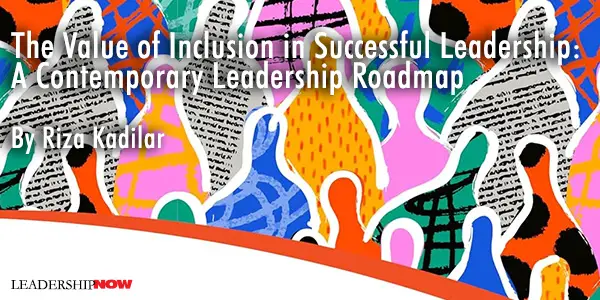 |
 |
09.26.25

The Value of Inclusion in Successful Leadership
AS organizations navigate the complexities of the 21st century — marked by rapid technological advancements, evolving workforce demographics, and global socio-political shifts — the need for a fresh approach to leadership has never been more pressing. One of the most significant shifts in leadership thinking is the emphasis on inclusion as a core strategic imperative. Inclusion isn’t simply a fashionable term or corporate social responsibility checkbox; it’s a critical driver of long-term organizational success. Why inclusion is so important, and why now? Inclusion has become a focal point in organizational strategies because the world we live in is more interconnected, diverse, and complex than ever before. The rapid pace of technological change, the increasing mobility of the global workforce, and heightened societal expectations for fairness and equality are reshaping the expectations placed on leaders and businesses. But what makes inclusion so critical today, beyond the external pressures, is that, at its core, inclusion is about creating an environment where everyone feels they belong, valued, and able to contribute at their full potential. It goes beyond diversity, which focuses on representation, and encompasses how that diversity is leveraged. In an inclusive environment, individuals aren’t just invited to the table — they’re encouraged and empowered to participate fully and authentically. This enables organizations to tap into the vast reservoir of creativity, innovation, and insight that comes from diverse teams. Consider the analogy of a seed and its environment. A seed’s ability to grow depends not only on its inherent qualities but also on the conditions of the soil, water, and sunlight that surround it. Similarly, even the most talented individuals need an organizational culture that nurtures their growth and allows them to thrive. Without inclusion, diversity can lead to friction, isolation, and disengagement. But with inclusion, diversity becomes a powerful engine for innovation and problem-solving. The importance of inclusion is also underscored by the changing nature of work. As automation and AI reshape industries, organizations need to harness the full potential of their human capital. Diverse teams, when managed inclusively, have been shown to be more creative, better at problem-solving, and more adaptable in times of change. In fact, a study by McKinsey found that companies in the top quartile for gender diversity were 21 percent more likely to outperform on profitability, and companies in the top quartile for ethnic diversity were 33 percent more likely to have better financial performance. Inclusion fosters a culture of psychological safety where individuals are encouraged to take risks, voice unconventional ideas, and challenge the status quo — key ingredients for innovation in the digital age. Additionally, the rise of AI poses a unique risk. If AI systems are trained on biased data or monocultural perspectives, they risk perpetuating and amplifying existing inequalities. Leaders must be mindful of how they design inclusive environments not only for their human employees but also for the technologies that will shape the future of work. Inclusion, therefore, isn’t just a moral or ethical imperative; it’s a strategic necessity. Organizations that fail to embrace inclusion risk falling behind, not only in their ability to attract and retain top talent, but in their capacity to innovate and adapt to the challenges of the future. Rethinking leadership for the future One of the most profound shifts in leadership thinking is the move from leading individuals to leading relationships. In the past, leadership was often about managing people — assigning tasks, overseeing performance, and ensuring compliance. But as organizations flatten their hierarchies and embrace cross-functional, team-based structures, the real leadership challenge is in managing the relationships and dynamics within teams. How team members interact, share information, and resolve conflicts is often more critical to success than the performance of any one individual. In this context, the role of the leader is to act as a facilitator — someone who nurtures trust, fosters open communication, and ensures that every team member feels heard and valued. This requires a high level of emotional intelligence and the ability to create a psychologically safe environment where people can express vulnerability and dissent without fear of retribution. Leaders who excel in this area are able to harness the collective intelligence of their teams, leading to more innovative and effective outcomes. Another important shift in contemporary leadership is reflected in the increasing emphasis on purpose-driven leadership. Today’s employees, particularly Millennials and Generation Z, want to work for organizations that align with their values and contribute to the greater good. Leaders who can articulate a clear sense of purpose and connect their team’s work to a broader mission are better able to inspire and engage their employees. Purpose-driven leadership supports inclusion because it creates a common goal that transcends individual differences and unites people in pursuit of something bigger than themselves. A third contemporary leadership shift involves asking the right questions. Leaders today aren’t expected to have all the answers — in fact, it’s impossible to in these times of rapid change and complexity. Instead, effective leaders are those who ask the right questions, challenge assumptions, and encourage a culture of curiosity and continuous learning. This approach is particularly important for inclusion because it encourages leaders to seek out diverse perspectives and question their own biases. One of the most powerful questions a leader can ask is, “Whose voice are we not hearing?” By actively seeking out the perspectives of those often excluded from decision-making processes, leaders ensure their organizations are truly inclusive. The roadmap for increasing inclusion capacity Building an inclusive culture isn’t a one-off initiative; it’s an ongoing process that requires intentionality, reflection, and action. Follow this roadmap for increasing inclusion capacity in your organizations: 1. Measure inclusion and listen to your employees The most effective way to understand whether an inclusive culture exists in your organization is to ask the people within the organization. Surveys and feedback mechanisms can provide valuable insights into how employees feel about their ability to participate and belong. For example, ask employees to rate various aspects of their experience — whether they feel listened to and recognized for their contributions. These ratings can help leaders identify specific areas where inclusion efforts may be falling short. For example, if employees report feeling excluded from decision-making processes or if certain groups consistently score lower on measures of inclusion, leaders can take targeted actions to address these issues. 2. Model inclusive behaviors Inclusion isn’t just about policies and procedures; it’s about behaviors. Leaders must model the inclusive behaviors they want to see, such as being intentional about recognizing and celebrating diverse perspectives, fostering open communication, and creating spaces where all voices can be heard. One way to reinforce inclusive behaviors is by establishing inclusion ambassadors — individuals who champion inclusion across the organization and serve as role models for their peers. For example, in large multinational corporations, inclusion ambassadors might be tasked with identifying and sharing stories of inclusion in action. Perhaps it's a manager who goes out of their way to mentor underrepresented employees or a team that collaborates across departments to solve a complex problem. In highlighting these examples, organizations build momentum around inclusion and encourage others to follow suit. 3. Get to know your employees beyond their job titles Inclusion requires leaders to go beyond surface-level understanding and develop deeper relationships with their employees. This means getting to know what motivates them, their values, and how they respond in different circumstances. Organizations can facilitate this by creating opportunities for employees to share their stories and connect with one another on a personal level. This could take the form of hobby groups or cross-functional projects that encourage collaboration between employees who may not typically work together. 4. Equitable treatment, not equal treatment A common misconception about inclusion is that it involves treating everyone the same. Yet true inclusion recognizes that different people have different needs, and equitable treatment requires acknowledging and addressing those differences. For example, a working parent may need flexible hours, while an employee with a disability may need certain accommodations to perform their job effectively. Leaders must be attuned to these needs and ensure that every employee feels supported in a way that enables them to contribute their best. 5. Recognize and celebrate good work Recognition is a powerful tool for fostering inclusion, but it must go beyond individual achievements. In an inclusive culture, recognition should be about celebrating the collective success of teams and acknowledging the contributions of all members. Leaders should make it a point to regularly recognize not only what their employees achieve but also how they achieve it — highlighting behaviors that promote collaboration, empathy, and inclusion. Celebrating successes collectively reinforces the idea that everyone’s contribution matters and helps to build a sense of shared purpose. It also creates a culture where employees feel encouraged to support one another, rather than compete for individual accolades. 6. Commit to continuous learning Leaders and employees alike must be open to learning about their own biases, understanding different perspectives, and developing the skills needed to support inclusion. Organizations that prioritize continuous learning are better equipped to adapt to changing demographics, market conditions, and technological advancements. They’re also more likely to foster a culture of innovation, where diverse perspectives are valued and new ideas are encouraged. Essentially, inclusion isn’t just a nice-to-have — it’s a strategic imperative for organizations looking to succeed in today’s complex, fast-paced world. As we move forward into an increasingly diverse and interconnected world, the organizations that thrive will be those that not only embrace diversity, but also create the conditions for true inclusion. Now is the time for leaders to step up, model inclusive behaviors, and guide their teams toward a more inclusive, prosperous future.  
Posted by Michael McKinney at 04:43 PM
|
BUILD YOUR KNOWLEDGE
 

How to Do Your Start-Up Right STRAIGHT TALK FOR START-UPS 
Grow Your Leadership Skills NEW AND UPCOMING LEADERSHIP BOOKS 
Leadership Minute BITE-SIZE CONCEPTS YOU CAN CHEW ON 
Classic Leadership Books BOOKS TO READ BEFORE YOU LEAD |